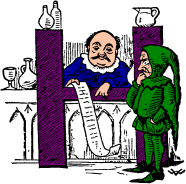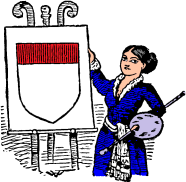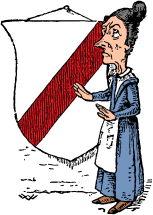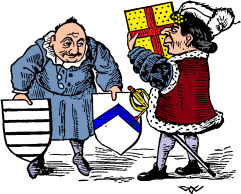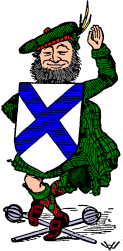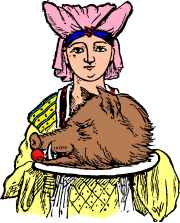HOME
Preface
Introduction
1
2
3
4
5
6
7
8
9
10
11
12
13
14
15
16
17
18
19
20
21
22
23
IX
CHAPTER IX.
OF CHARGES AND ORDINARIES.
AVING settled our differences, let us hope satisfactorily, we come next to what in common life often leads to them, especially when made by tradespeople, viz.:--Charges. These charges, however, must not be confounded with those made before a magistrate, or in a bill, nor yet with the prices paid to the Heralds for finding an Heraldic coat. Sooner than such an imputation should be made upon them the English King of Arms would hang himself in his own garter; Lyon, the Scotch King, would bite off his own ear; and Ulster, the Irish ditto, would smother himself in his own Ulster coat.
Charges are the figures expressed on a coat of arms, and we will now proceed to add them up.
We must premise by saying that they consist of everything depictable (to coin a word) either in or on the earth, air or sea, besides a great many other things which never could, would, ought, might, or can be found anywhere but in the brains of the Heralds.
Having thus eased our minds in regard to them, readers will please take note that of charges there are six kinds. 1. Ordinaries, which have no connection either with the chaplain of Newgate, who is also an ordinary, or with tables-d'hôte every day at one and four. These ordinaries,--the Heraldic ones are entitled "honourable,"--to distinguish them from 2, the "Sub-ordinaries," which anyone who was rash in jumping at conclusions would of course say were the dishonourable kind. The only objection to this would be that it was perfectly wrong, seeing that they are nothing of the sort.
Next comes number 3, "Common Charges," which might again be supposed to include those of wife-beating, adulteration of food, conspiracy of directors of bogus companies, &c., which are very common now-a-days--only they don't.
Four--Natural Figures. What these are, and are not, we will explain when we come to them--a promise we will also fulfil in re 5 and 6, Artificial and Chimerical Figures.
The honourable ordinaries are nine in number, in that resembling the muses, and if we can only make each of them amuse, the likeness will be still further carried out.
First of all we have, as might be expected, the "Chief." This charge consists of a bar occupying the upper third of the shield.
Next we have the "Pale." This charge takes up the third of the shield perpendicularly, and would seem to be better adapted for the arms of a sickly girl than a stalwart knight. It has two diminutives--the "Pallet," half the size of the pale, which is clearly intended for the cognizance of a painter, who would of course put his own colours on it; and the "Endorse," half the size of the pallet, the bill broker's own charge. One might naturally expect the renewal and the protest to follow ; only, by some unaccountable omission, they are not included in Heraldry.
Thirdly comes the "Bend," which consists of two diagonal lines from right to left. It has four diminutives--the "Bendlet," the "Garter," the "Cost," and the "Ribbon." By the association of the last two we might almost fancy that the Heralds, under the guise of their, science, were slily poking fun at the ladies.
Fourthly, the Bend Sinister. This is the same as the bend, only from left to right. It is usually, but not always, the Heraldic sign of illegitimacy, and has two diminutives,--the "Scarp," and the " Baton,"--which latter smacks more of the Orchestra than Heraldry, and also strikingly suggests the policeman on duty.
Fifthly, the "Fess." A bar occupying the middle third of the shield, over which we shall bolt to the Bar itself, which is the fifth ordinary, and only takes up a fifth of the escutcheon. This is never borne singly, and when there are five bars, the shield is said to be "blazoned barry," which naturally calls to mind the Revalenta Arabica food, and perhaps the name was invented by some grateful Herald restored to health after years of "indescribable agony," by the use of that much-vaunted condiment. The bar has two diminutives, the "Barrulet," and the "Closet," which we shall now shut up, and proceed to.
The "Chevron," the seventh ordinary. This is in shape like a rafter used to support a roof, and hence is sometimes called the "Spar." For a fighting man in training this would be eminently adapted. The eighth ordinary is the "Cross." In Heraldry, as in life, there are various crosses: but as advertising tradesmen say, none others are genuine but the plain cross, consisting of two bars, one horizontal and the other perpendicular. We therefore beg our readers to beware of all spurious imitations calling themselves ordinaries.
Last of all comes the "Saltier," which is neither more or less than a St. Andrew's cross, and is so called by both German and Scotch Heralds. The last-named gentlemen would, of course, lose no opportunity of glorifying the "Land of Cakes and of immortal Burns," and their proverbially canny character is shown by their seeking to obtain a larger measure of honour from the ordinary by bestowing it upon their own private and particular saint, thus making it, in fact, an extraordinary.
This ends the list of honourable ordinaries. In our next chapter we shall attack the Subordinaries, which may be regarded as a sort of Heraldic cuisine a la cookshop, in contradistinction to the more aristocratic food of the honourable ordinaries.
IX
1
2
3
4
5
6
7
8
9
10
11
12
13
14
15
16
17
18
19
20
21
22
23
Preface
Introduction
HOME
Build: 2019/04/20 14:20:08.59+0900(JST)


